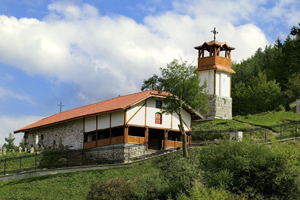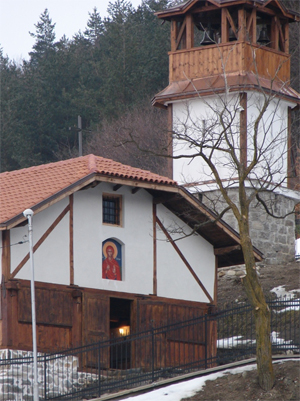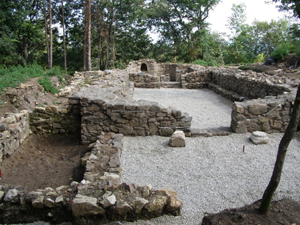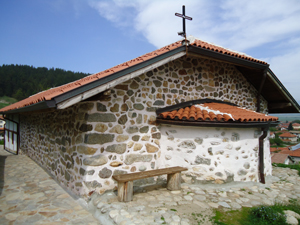
The village of Belchin is located in the picturesque valley among the mountains Rila, Verila, Vitosha and Plana, at an altitude of 930 m above sea level. It is situated at about 15 km from the town of Samokov and around 50 km from the Capital city of Sofia. The weather in winter is mild and in the summer is cool. The air is quite fresh and the nature is comparatively virgin. There is a spa of 41°C and with proved therapic and preventive effect on the support musculoskeletal system of the human beings.
The village is located in the immediate vicinity of centuries-old beech and pine woods and its nature is noted for its rivers, springing from the Verila mountains. In the vicinity of the village, the Palakaria River flows and springs from the Vitosha mountains and flows into the Iskar river. The highest summit the Great Debelets (1415) is, at the same time, the dullest mountain in the Turkish ravine neighbourhood, however, it offers many virgin spots untouched by people. There are freshwater springs for which there is a legend that the ancient Trakies had drunk from these springs during their travels through the area. These springs are located in faraway places, inside the breech woods and one could only drink from them once a year. They are some small holes in the ground where crystal clean freezing water springs, but even locals are only aware of the availability of few of them.

The village of Belchin has existed since the Second Bulgarian Kingdom. Some investigators refer it to a far-off antiquity - founded by the Romans. Once it had the name Tsari Mali Grad. At any rate, it is about a settlement of a millennial history associated with the neighbouring villages its means of livelihood as well as its common traditions and culture. The temple “Saint Petka” is located on the hill Saint Spas above the village. It has undergone several stages of construction and reconstruction. In its present form, it was built in the fourteenth century on the grounds of another temple dated from the the thirteenth to the fourteenth century. Later it has undergone an unknown cataclism. During Renaissance the liturgical hall of the present measures were widened, however, the stone vault has already been replaced for a wooden one.
There are two churches in the village: “Saint Apostles Peter and Paul” built in 1883. The icons and frescoes in it are the life's work of Nikola Obrazopisov – an eminent representative of the Samokov Art School. The other church in the village is “Saint Petka”. It has existed since the middle of the seventeenth century when it was built on the grounds of other temple dated from the 13th – 14th century. One of the most valuable icons – “the Holy Virgin and Infant” which is exposed in the Crypt as well as part of the remaining icons were painted in 1653. Those are rare art images created before the heyday of Renaissance. As Prof. Valentin Angelov put it, the woodcarving in the temple “Saint Petka” in the village of Belchin are amongst the most significant monuments of the monumental woodcarving in Bulgaria in the period between the 14th and the beginning of the 20th century.
The state of the temple “Saint Petka” in the last decade of the last century led to the collapse of the roof, part of the walls to the strong damage of the chrch’s stock. Since the temple has been declared as a national monument of the art culture first category , its revival is of great significance for the culture and development of the region and the country. That’s why on the initiative of the foundation “Revival of Belchin” and with the support of the founder of the church work on the whole restoration of the temple “Saint Petka” has begunaiming at maximal keeping то the original and the remainings of the original.
The region of the village of Belchin has turned into basis for the development of modern cultural historical balneological and echo tourism at a European level. Projects for the restoration and construction of other monuments of culture, are to be realised, echo paths are to be set apart, modern spa and balneological centres are to be developed, local celebrations are to be organised and local traditions are to be revived and some other activities lie ahead.

At the end of 2006 with the participation of different scientists and researchers in the region of Belchin, conducting archeological studies of a whole centre began: chrch, necropolis and a site of an ancient town erected right over the village and looking back on its history many centuries.
The archeological site is located on a flat terrace right under the top of a hill. Significant bumps on its surface are visible and considerable ruins are probably concentrated under them. Before the beginning of our job there, the fortress had not been a subject of a serious scientific interest and we had obtained information about it mainly from local informers, as well as from the modest description of the site and the visible ruins on it and collected around 30 years ago in a master’s thesis dedicated to the antique fortification in the region of Samokov.
Geodesic photographing of the visible structures has been done and a plan has been developed – square net aiming at regular archeological studies. It has been found that the fortress has got an irregular form built on the crown of the flat terrace surrounded from the north, east and west by some steep slopes and an artificial ditch and a bank from the south where it is more accessible. There is the very rectangular tower invariably linked to the fortification of the fortress wall and it closes an area of 9000 m2. The tower has been well-defined visible as a result of treasure-hunters’ excavation. Some walls built from broken stones and white crumbling porous mortar have been discovered. After cleaning the walls, it was found that they are two different walls stuck to each other on a thin joint, i.e. a secondary thickening of the wall.
In the process of tower building, brick belts have been discovered on the adjacent walls. Four consecutive rows of square bricks have been cleared. They have shown unambiguously that they concern the building of at least four-row opus mixtum from bricks which measure 0.27/0.27/0.04 m laid on a thick layer of mortar with joint of 0.03 m between the rows. The brick belt has been preserved partially and followed terraced thank to which observations have been made about the way of their laying out in it.
After the removal of the mixed layer with ruins of the tower building and black bulk soil you can reach a better expressed and comparatively homogeneous layer of opal clay and ash at a level of 0.40m from the level of the preserved walls of the tower. Actually that level conforms to the floor of the tower about which we conclude by the mortar screed of the lowest joints from its internal face. The layer of opal clay and ash is followed at a depth up to – 0.6m – (at 0.20m under the tower’s floor level) where sterile layer has not been reached yet. Within the drilling process in sito the lower parts of two medium – large питоса have been discovered. They have been destroyed in the process of collapse of highly preserved parts of the facility and some single fragments from their opening as well as a fragment of gray late-antique dish closed to the type familiar to the Popovyane team.
The corners of the gate of the wall of the fortress are flanked by large rectangular towers. Up till now 3 have been discovered. Their construction has been made of cut rocks of mortar with equalizing brick joints of the technique opus mixtum. The geographic study made this year has registered the gate very precisely, as well as the presence of attached buildings to the walls of the fortress. The investigated area so far in this part is about 600 m2. The chain plan of the buildings of perishable material (wooden construction plastered up with clay and tiled roof) and the discovered trails in them of firesides, iron instruments, weights for scales, weights from a vertical loom show the economic nature of the premises. The coin find date the inhabitance in the settlement from the end of the fourth century to the sixth century. The archeological structures are multilayer and mark the dynamics and the course of inhabitance. The drilling done in the interior of the settlement has also surprised the archeological team with earlier finds – from the late bronz age. Strong fragment cult ceramic has been found in the dicovered rock collapse and pits, which displays the presence of Trakian holy site from about the Troyan war period.
The discovered Christian cult site assumes strong religion engagement of the hill. It is located immediately to the north of the gate of the fortress. Earlier architecture ruins have been registered and studied around the excavated medieval church in 2007. Thus, we can familiarise, by the data we got at this stage, that we can relate the medieval Christian temple to around 15th – 16th century. Its parameters – measured on the internal sides are – length without the vaults – 14.50m, length of the naoses (part of churc) – 10.50m and width on average – 4.70m (its middle part is about 4.50m), the side of the altar space – 3.30m and of a square form and diameter – 1.50m and depth of 1.10m. The small niche on its north is 0.50m deep, for the external sides and walls at least in the east investigated part cannot be assumed because their trenches for their count in the northern and north-east part of the temple had probably been put up under the level of the ancient site rather than being substructions. This specifies the church as semidug, however, above a specified height, its superstruction has been erected, while in its west part, the church has been above the ground almost completely and only there we have succeeded in measuring the thickness of the wall – 0.75m, and we could claim that there are formed external sides.
Expanding the sphere of study, it has been found that the medieval church from the 15th century has been dug on destructed early Christian basilica from the end of 5th – 6th century. Its has been built using cut rock and link of white mortar. The preserved superctruction of the walls of both side anexes is almost 1m. the planing solution is familiar for this region – long and narrow naos, entrance and an open and half-closed from the west and north, while the oltar part has been formed with anexes (independent premises with open passage towards Presbytery, similar to prosthesis and deaconicon like those in the planning decision of the basilica with a nave and two aisles). The medieval church is located wholely on the foundations of the central ship. The discovered finds of coins and fibula of the type “leg curled under” on a floor level ans around the foundations of the oltar part date the church at around the end of 5th century. There are no parallels of similar type early Christian basilica from the near surroundings, strange as it might seem, we have discovered parallels for now in nowadays Macedonia.

The Saint Sophia Church formerly the cathedral temple of the city of Okhrid and headquarters in the autocephalous okhrid archbishopric. It is unknown when it was built. During the 1950s partial drilling studies were carried out and they date the early church at “Ustinyan times” or most common in the 6th century. The possibility that prince Boris Michael around the end of 9th century had built the cathedral on the foundation of ancient Christian remains also exists. Later in 1317 the church was rebuilt in this very state. On excavation in 1984 – 1985 in the central part of the Presbyteria, marble plate with shaped ends was discovered, i.e. mensae martyrum. It is supposed that the church is a martirium with one or more graves of saint martyrs. Again as martyrs two other churches in Strumitsa and Demir kapia were defined.
When the early plan of the church of Belchin was reorganised, we came to a conclusion that our church type is of the church dedicated to Saint 40 Sebastian martyrs located in the suburbium of the old bishop’s centre Strumitsa, i.e. cross-like church inscribed in a square, such are the usual martiriite located with side pastophors (anexes). Thus the central ship or naos is dedicated to the common cult of the Lord’s Table while the southern pastoforii next to the Presbyterium is another incorporated church, cross-like martirium dedicated to the relics of some local saint or saints.
Actually, in the southern annex of the church next to the Г-like bench and under the mortar floor, we discovered the remains of emptied grave pit, roughly filled in with the remains of fragmented pithos. Other two grave pits were located in the northern open gallery in front of the entrence of the annex. We have discovered the remains of ritual practice in pit 1, that one in the southern annex. There on the filled in pit, we discovered charred grains, kernels and a skeleton of a bird which could be interpreted as continuous ritual respect even after taking out the skeleton or relics. What had happened to the skeletons? Accounts of Saint Grigorius Naziansky and Saint Pauline from Nola give us an answer to this question. They narrate that in some churches, there is only a fraction of martyrs proclaimed as saints. By means of considerable building of churches in the Christian world, even every a small fragment of relics of local or famous great martyrs is considered of a great value for the church. Ever since the ancient times and most of all in the medieval it was reached to the so called Furta Sacra or “sacred” stealing of relics of martyrs. That is why, the decree of Theodosius 1st in 381 says about how much the trade of relics and excavation of many tombs of martyrs was developed that every resale and trade with relics of Christian martyrs – saints were banned.
The greatest surprise was the reveal of the third even earlier ancient Christian church located at 1.30 m depth whose abside is 3.50 m deep and comes from church №2. Its plan, for now, is of a basilika, however, its measures are shocking, almost as the present Mitropolitska (Bishop’s) church in Samokov. Unfortunately, the remains of the walls are only preserved up to 1 – 2 stone rows and a very limited part of the floor level, but even so the walls of the oltar section and both entrences towards the spacious oltar space are clearly seen. The discovered collective monetary find immediately next to the oltar section date the church from the 90s of the 4th century.
It is obvious that the fortified settlement in monastery Saint Spas near the village of Belchin was well-known and significant early Christian centre of expressed domestic, cultural and clerical life.
The period of the late ancient time has been registered with wide-scale culturalogical, political and ethnical changes, remaining lasting trails in the layers between two еmpires – the Roman Empire and the Bizantine Empire. Rich clerical and mterial culture of the local Trakian population is in symbiosis with the developed Roman civilization and the combination of fine climate and natural givings turn the present Bulgarian territories into an attractive centre and desired place for many nations. For a few centuries from here hundreds of thousands of people – Hun, Goth, Avar, Alan, Pechenegs … and all of them want a single thing – to settle lastingly on these territories. Some of them with fire and sword, others build the foundations of a developed proto-European civilization with labour and constancy.
Specifying dating and processing of hundreds of finds – coins, arrows, ornaments, ceramics and tools…continues. They will soon be exposed at the cultural historical and religion complex in Belchin – branch of the History Museum – Samokov.

The Ethnographic Museum in the village of Belchin was built in 2007 as a branch of the Historical Museum – town of Samokov. It is located in the vicinity of the medieval temple “Saint Petka” at the foot of the hill “Saint Spas”. The lifestyle in the village from the end of 19th century – the beginning of 20th century. The exhibition is a thematic one starting with acheology and old print literature passing through means of livelihood and skills practised in the village reaching traditional clothing, fabrics and household objects. The building is a two-storey one as archeology and old print literature are on display on the first floor. The museum exhibit is typical here where finds discovered on the hill Saint Spas are exposed. A typical Belchin rich house from the beginning of the 20th century is presented in 4 premises on the second floor. In each room visitors can see what a veranda, odaya (room), soba (bedroom / stove) and work room were and namely what they were used for. The farm equipment, inherent to the mentioned period is presented in the coutyard part, while poyata is located out on the way to the church “Saint Petka”. This is a summer pastoral hut in which visitors can see on display how milk is obtained and processed as it was the main means of livelihood in the village. The Ethnographic Museum enjoys a great interest and it has been visited by numerous tourists from our country and abroad.